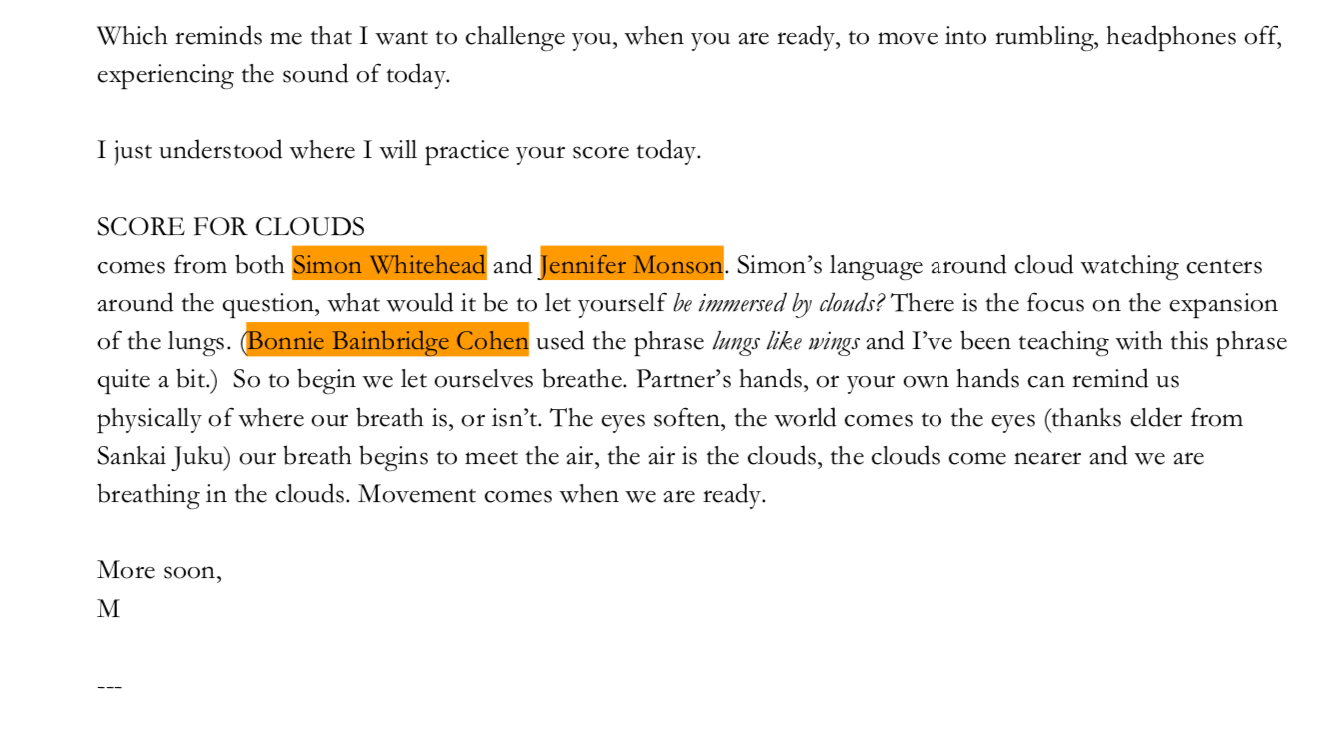
BECOMING INDOOR/OUTDOOR CATS
by Leah Wilks + Jessica Alexander







SCORES FOR ATTEMPTING TO BE AN OUTDOOR CAT
(i.e. practice these outside)
These scores can be done solo, with others, or in tandem with another person, but indifferent locations. Before embarking on any of the scores below, figure out a mode (or score) for arrival. This could be sitting in silence, talking with your fellow practice partners about “what’s on top,” (1) or any other practice that helps you arrive.
(1) Thanks Nia Love for this terminology!

10-10-10 (score for when it feels hard to start):
Pick 3-4 actions from the list below. Decide how many 30-40 minute cycles you have time to complete. Set a timer to go off every 10 minutes. Spend 10 minutes in each of your chosen actions until you have visited them all. Repeat the cycle. And, if you have time, repeat again.
Actions: Relocate, write, sit, move.
Also options: Observe your nearby surroundings with a narrow lens. Observe your surroundings with a wide and far-reaching lens. Each time you visit this score, allow your rendering of each action to change with your needs-physical or mental.
This score was adapted from a score passed to Jessica from Courtney Mazeika and Sarah Woods-LaDue and further refined with Madison Doyle and Jacqueline Kopra. It has appeared in many different contexts before and after. It is a multipurpose score that has helped us to start when it feels hard or better understand new places and old ones.


CLOUDS(score from Jennifer Monson/Simon Whitehead via Mauriah Kraker)→ Leah’s collaborator, Mauriah Kraker, sends her this SCORE FOR CLOUDS
We love the score, and use it both as a way to get into a relationship with clouds, and as a mechanism for beginning to develop other scores in relationship to weather...
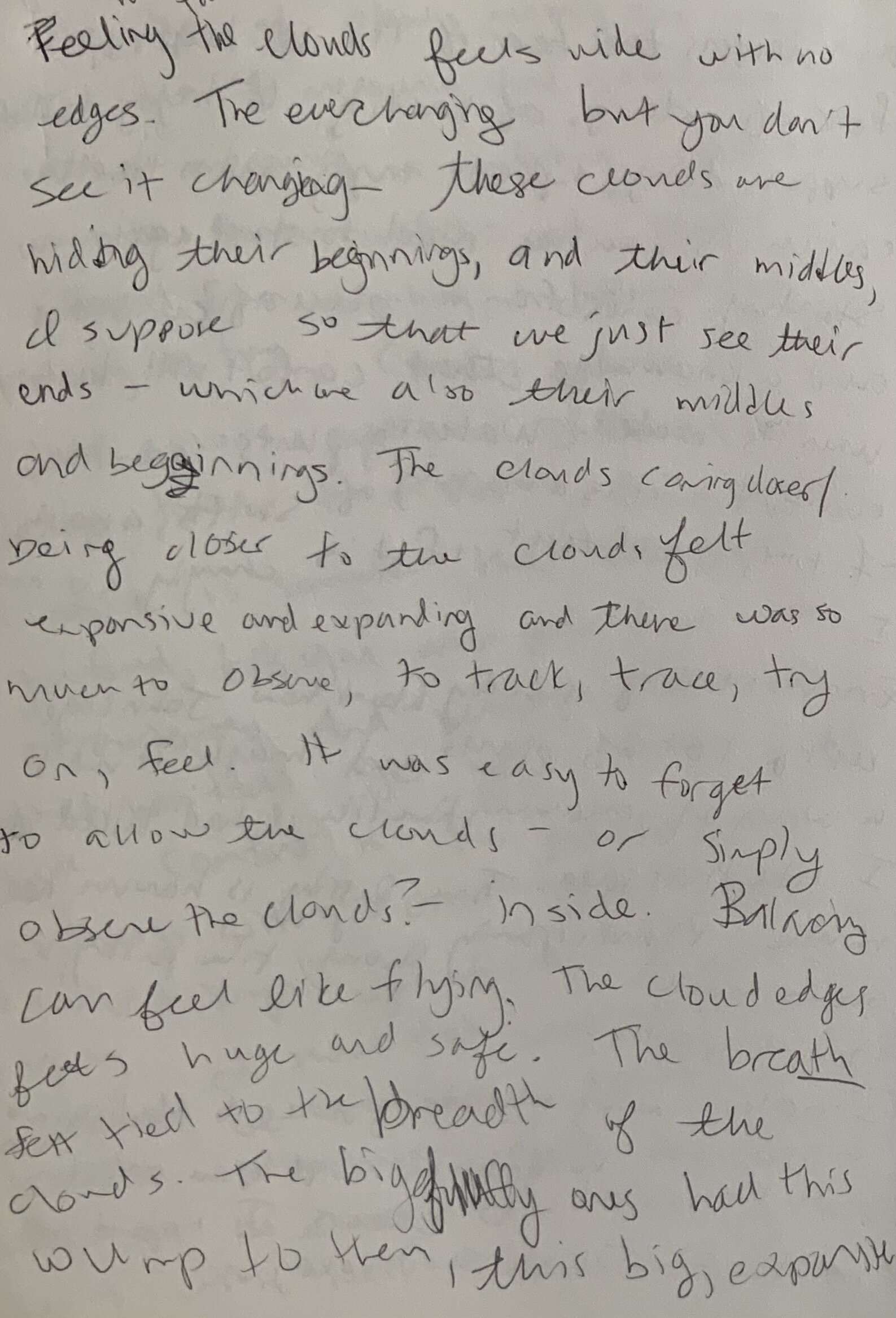
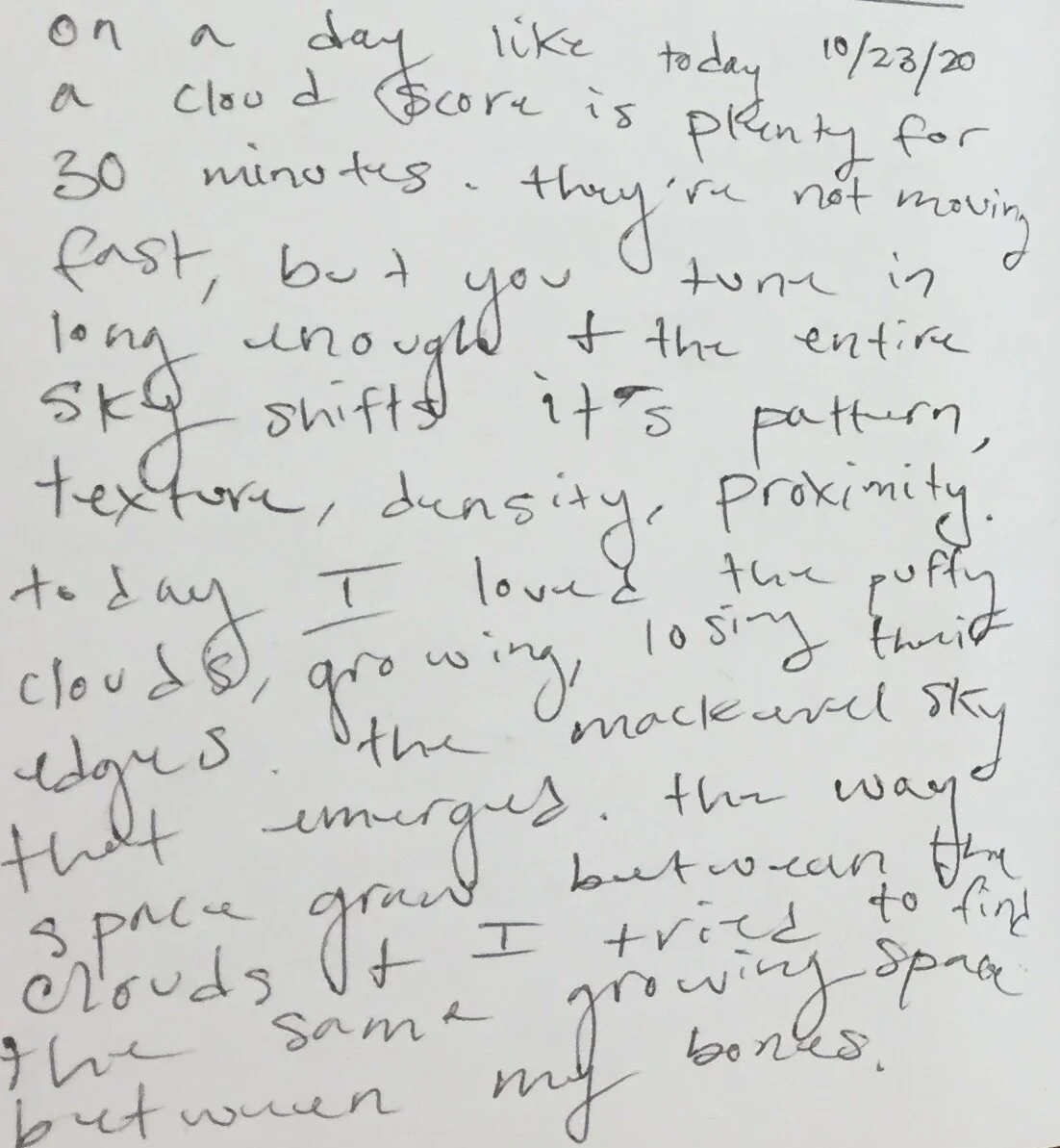

SUN (score #1 for touch, when it’s hard to come by):
Begin by lying/sitting/standing passively (or in stillness) in the sun. Perhaps close your eyes. Do this for at least ten minutes.Let the sun be your passive-solar warm up. Notice temperature on the different sides of your body. Observe how this interacts with your sense of comfort, the tension in your body, any holding/releasing. As the sun soaks into your skin/clothes, move in order to attend to temperature. Lean into this investigation of temperature by exploring both what your body is and is not drawn to. Can you invite in more luxuriousness, even in less-than-comfortable conditions? Could this temperature, this sun, be perfect for exactly the dance you are doing right now? If your eyes are closed, open them. What is the interaction with the sun through vision? Can you still hold onto the attention to sensation and temperature while also engaging with the light and shadow through vision?
WIND (score #2 for touch, when it’s hard to come by):
Begin still (upright). Close your eyes and begin to slowly rotate a full 360 degrees feeling the wind (or lack thereof) on all sides of your body. Choose a direction to move into, away from, or accross the wind. Decide which side of your body will be facing into the wind. Take 20 steps (or 50 if you like) in your chosen direction trying to match your tempo to the force of the wind. If the direction of the wind changes, try to keep your relationship to it the same. At the end of your steps, pause. Notice the first thing you notice. Respond to this thing in movement. When complete, repeat the whole pattern moving into/away/across the wind differently than the previous round. Go for 10 rounds, or as long as you like. When you finish, take a moment to note your orientation to the space you are in with all the information the wind provided you.

SURROUND-SOUND (score for when you’re stuck/need change):
Find a place where you can close your eyes. Observe what you can hear. Try to parse out one sound and then open your eyes. Begin moving in response, in tandem, or in anticipation of the sound. Let the sound guide you rhythmically for a time. Then perhaps let the quality of the sound infiltrate the quality of your movement. How does your distance from the sound interact with your movement? Repeat as many times as you like, attending to one sound at a time. If you like, after you have spent time deeply exploring each sound, begin to try them on at the same time (perhaps in different body parts, or quickly oscillating from sound to sound, or layering in your body, or, or, or....)
BACKSPACE (long score for dis/reorientation)
Decide on a space where you can move backwards for a distance. This could be long runways down and back or circular...perhaps the perimeter of a field. Decide if you want to begin upright walking backwards, on hands and knees crawling backwards, or on soles of feet and palms of hands bear-walking backwards. Know that you can change at any point. Set a timer for 45 minutes. Begin your backwards traverse going as slowly or quickly as needed. If your body gets tired, change your position or tempo. Attempt to not turn around to see where you’re going. When the timer goes off, pause. Notice the sensations in your body. Respond in movement for the next 10 minutes in whatever way arises for you.

MARGINS (score for dissolving edges):
Find a transition place (cement to gravel, sidewalk to grass, etc.). Choose a side to start on. Walk forward and when you arrive at an endpoint walk backward. Do this three times. Once on each side and once in the transition space. In each place notice what information about the ground passes through your feet. How your ankles feel. How does that translate or affect the rest of your body? Notice sound - the sound of your steps. Then take time to move between the three, noticing which ones you drift towards, how your movement changes, and what sounds are created. Walk the seam forward and backwards again, taking time to digest what you observed, what might feel different? Choose a side, and walk away.
FIND YOUR LIGHT (short score for a place with some shadow):
Set a timer for 10 minutes. Choose a direction to walk in. Start your timer and relocate yourself in that direction. When the timer goes off, find your light. Treat the surrounding flora and fauna as your audience. This space is your opera house.

RIVER (score for when it’s warmer):
Find a section of river/creek/stream/moving water without a strong current. Set a timer to go off repetitively every 7-10 minutes depending on how long you have. Step into the water. Start your timer and begin traveling in the direction of the flow of water (this could be walking forwards, walking backwards, crawling, wading…). When the timer goes off, pause, close your eyes and re-orient your facing. Open your eyes and briefly respond in movement to the first thing you notice (this could be visual, but also could be a sound or other sensation). Consider this as a light documentation of this particular node in the river. When you feel done documenting, begin traveling with the flow of water again. Allow any humming or singing or vocalizing to arise as you traverse, or simply tune into the soundscore around you. Repeat for as long of a stretch of river as you feel like going. When you are done, climb out and give yourself a moment to feel the difference. Walk back along the bank, or wherever on dry land is safest to return to your original starting place.
Jess and Leah reflect on Indoor/Outdoor Cats
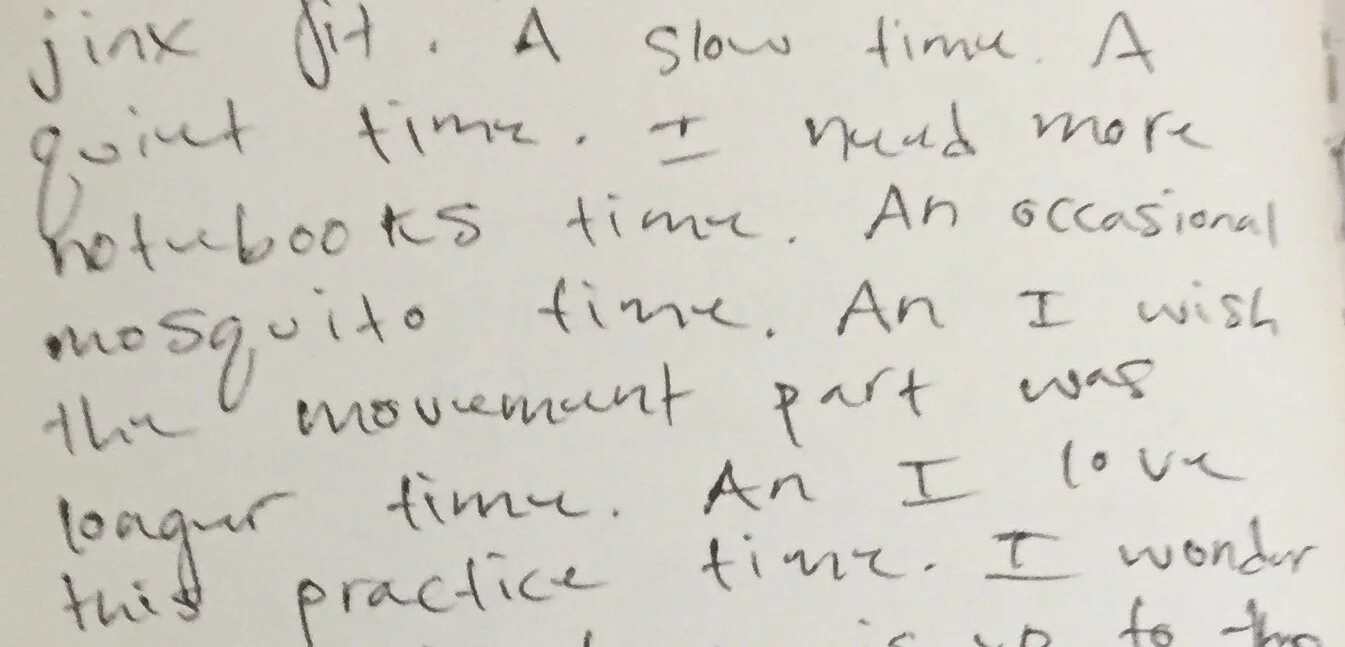
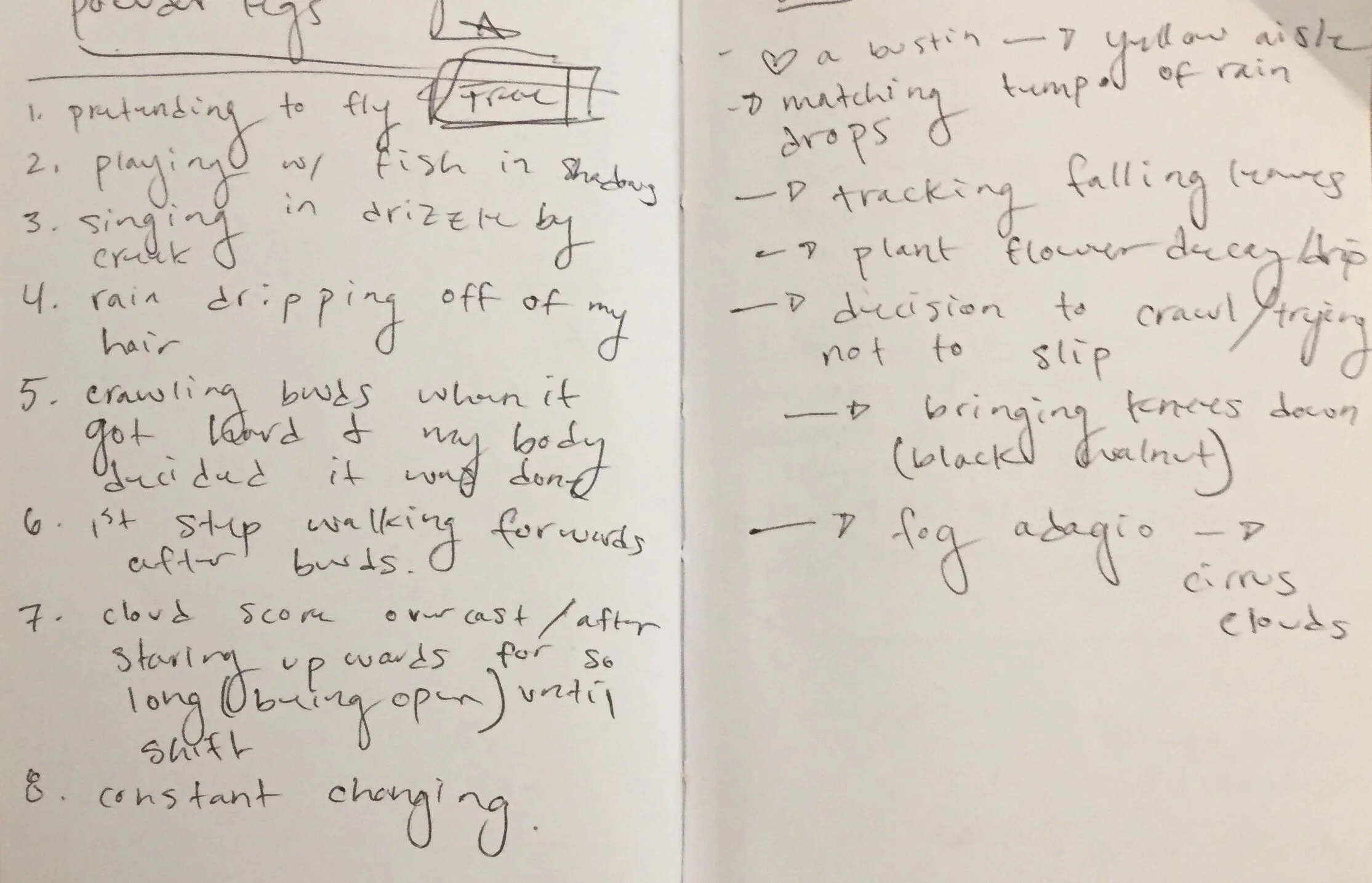
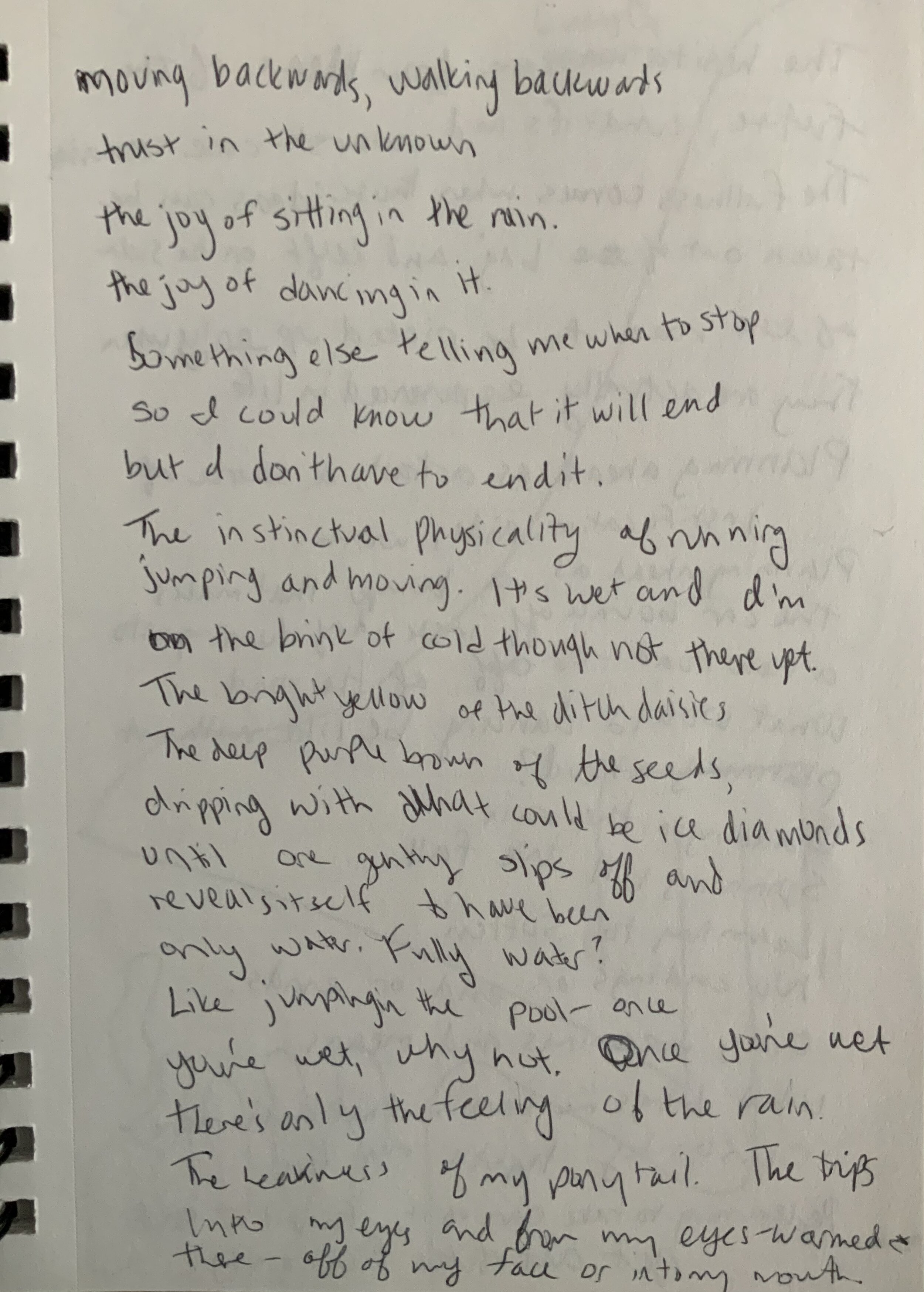
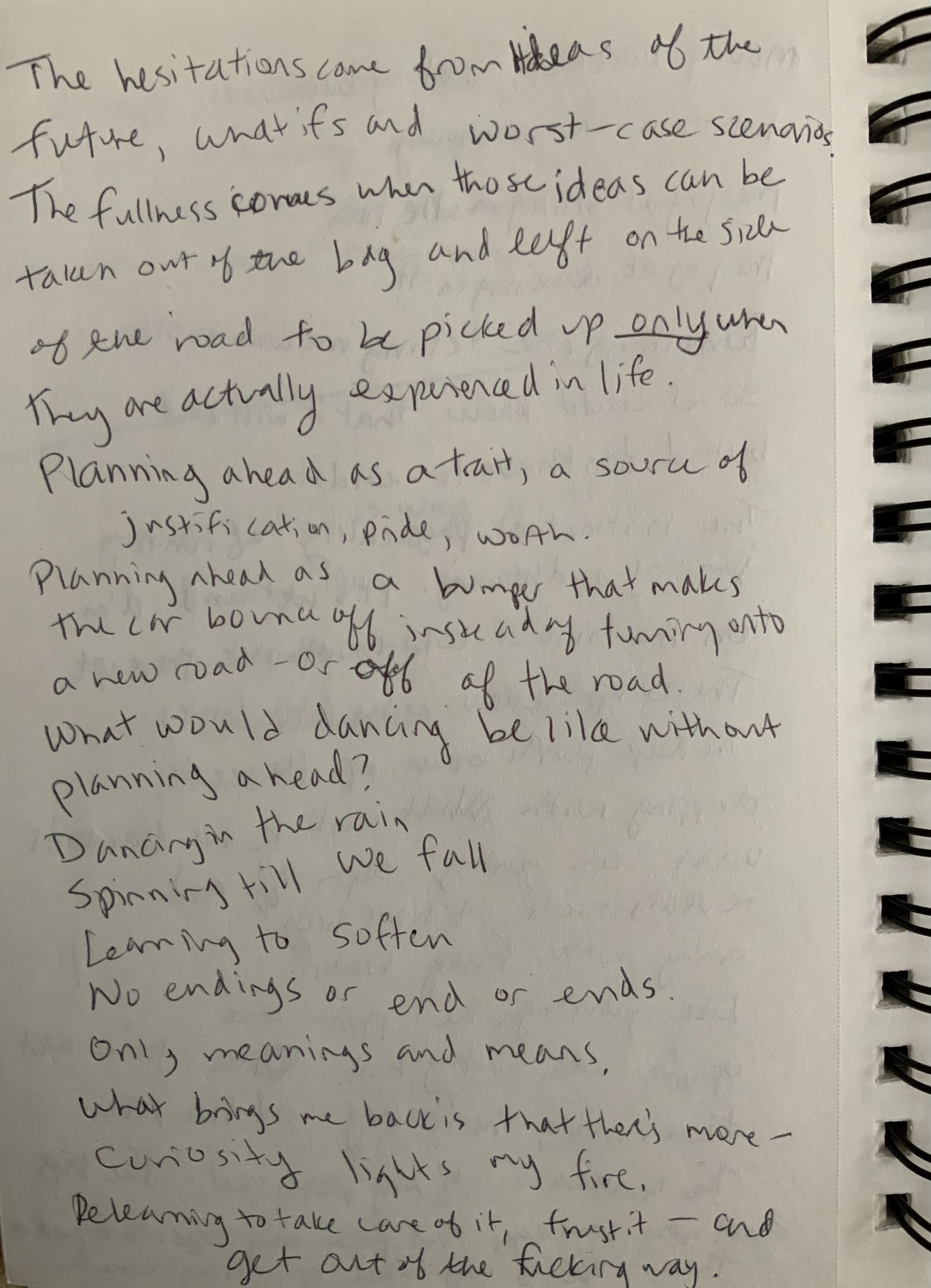
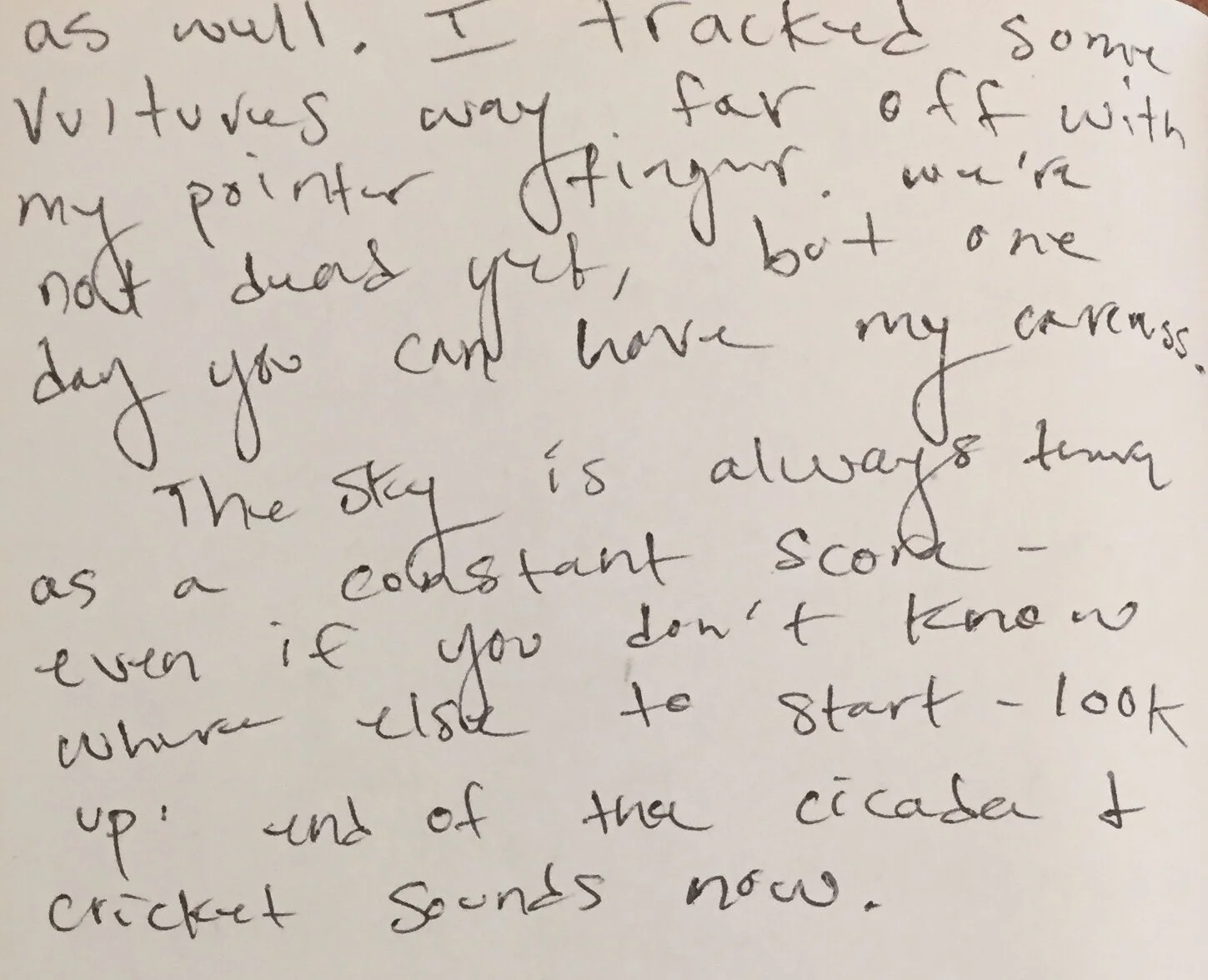
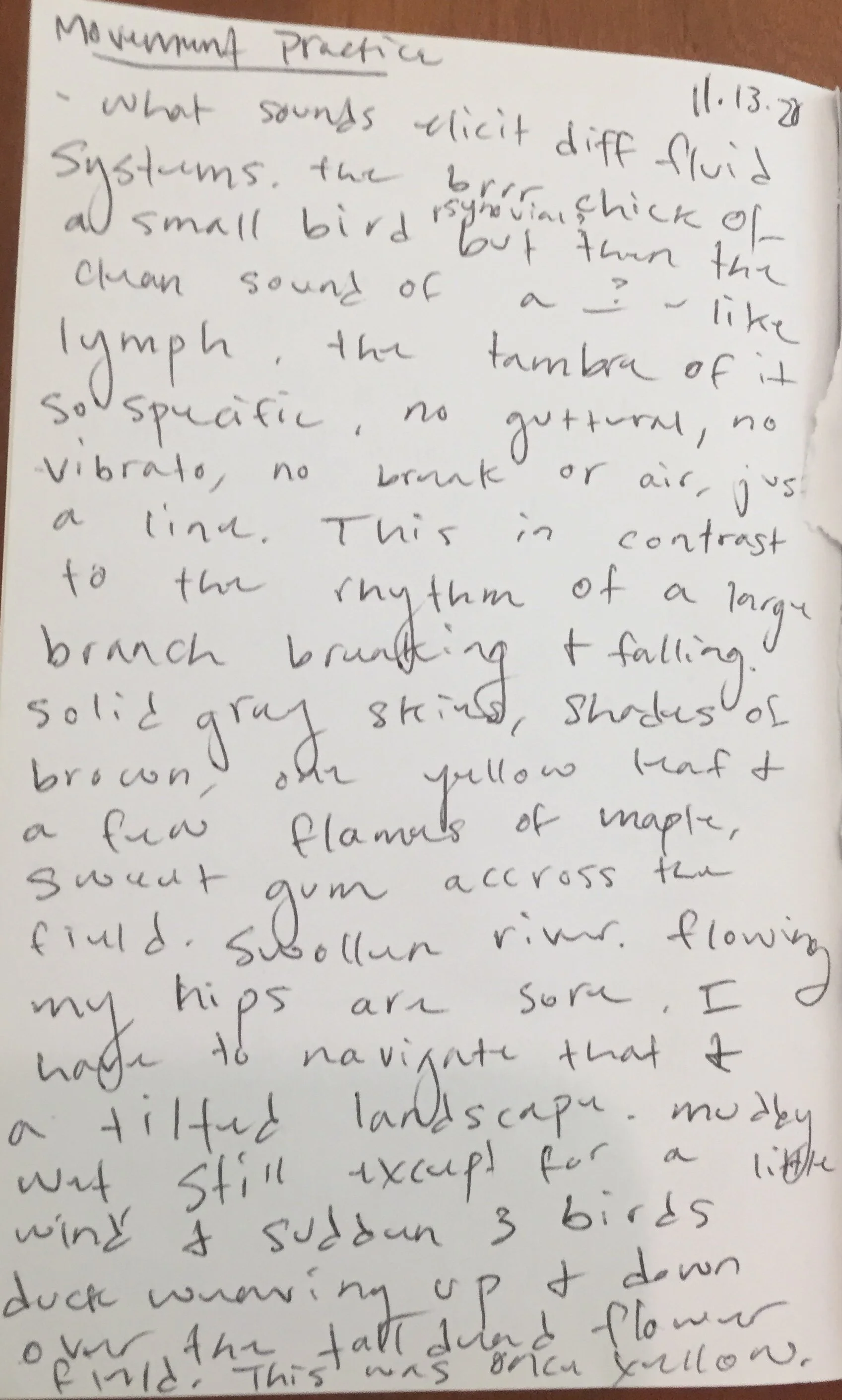
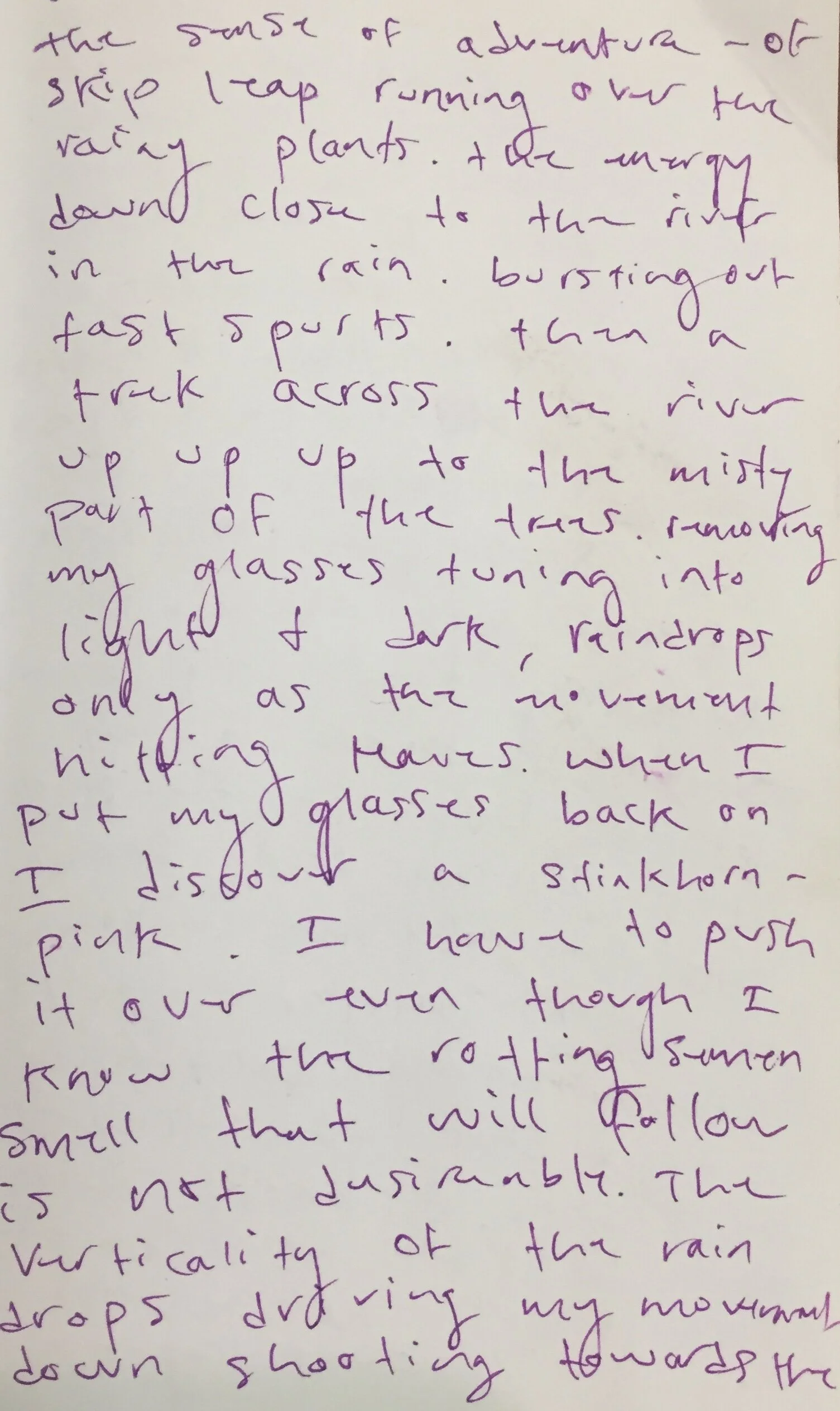
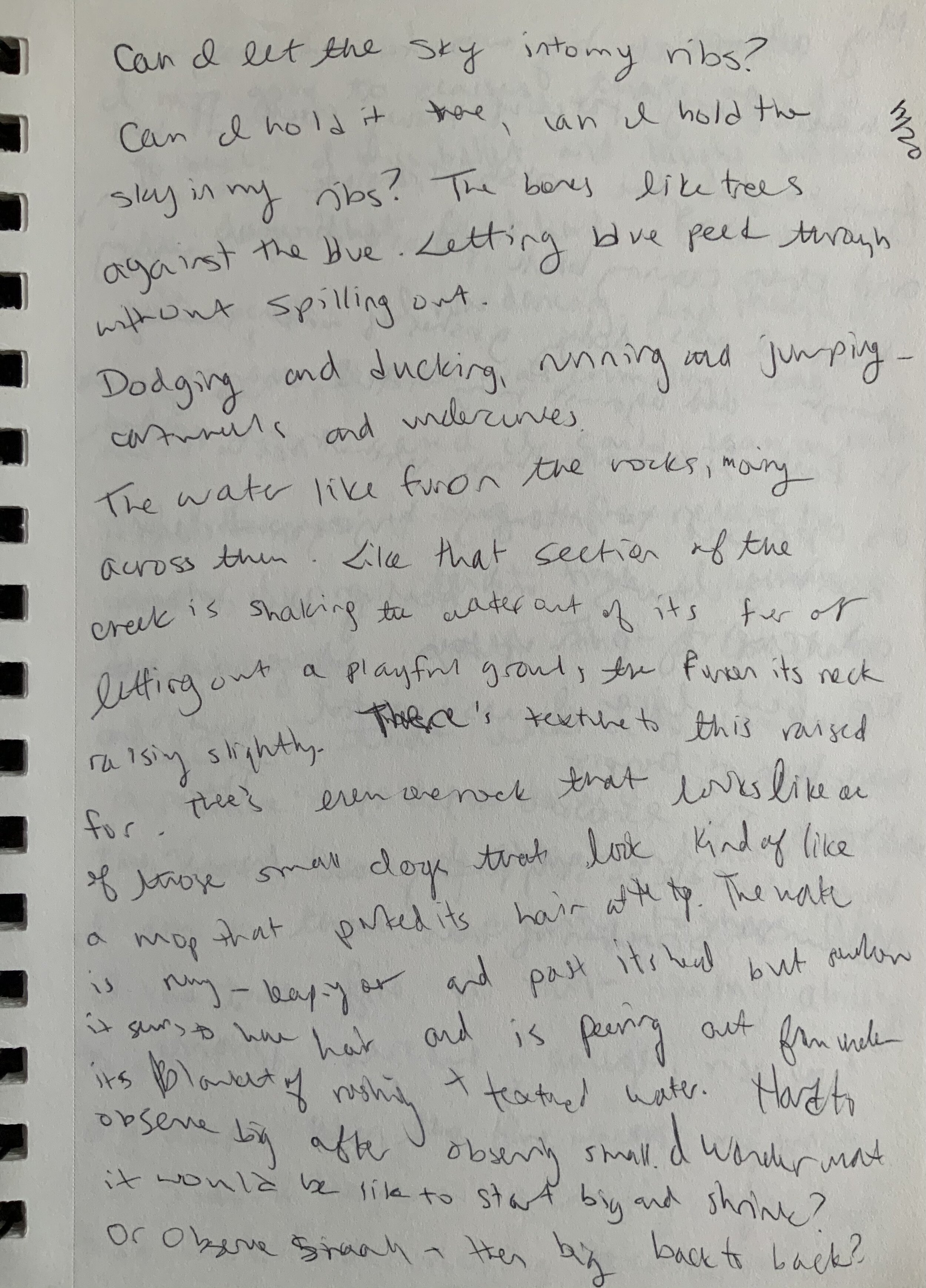
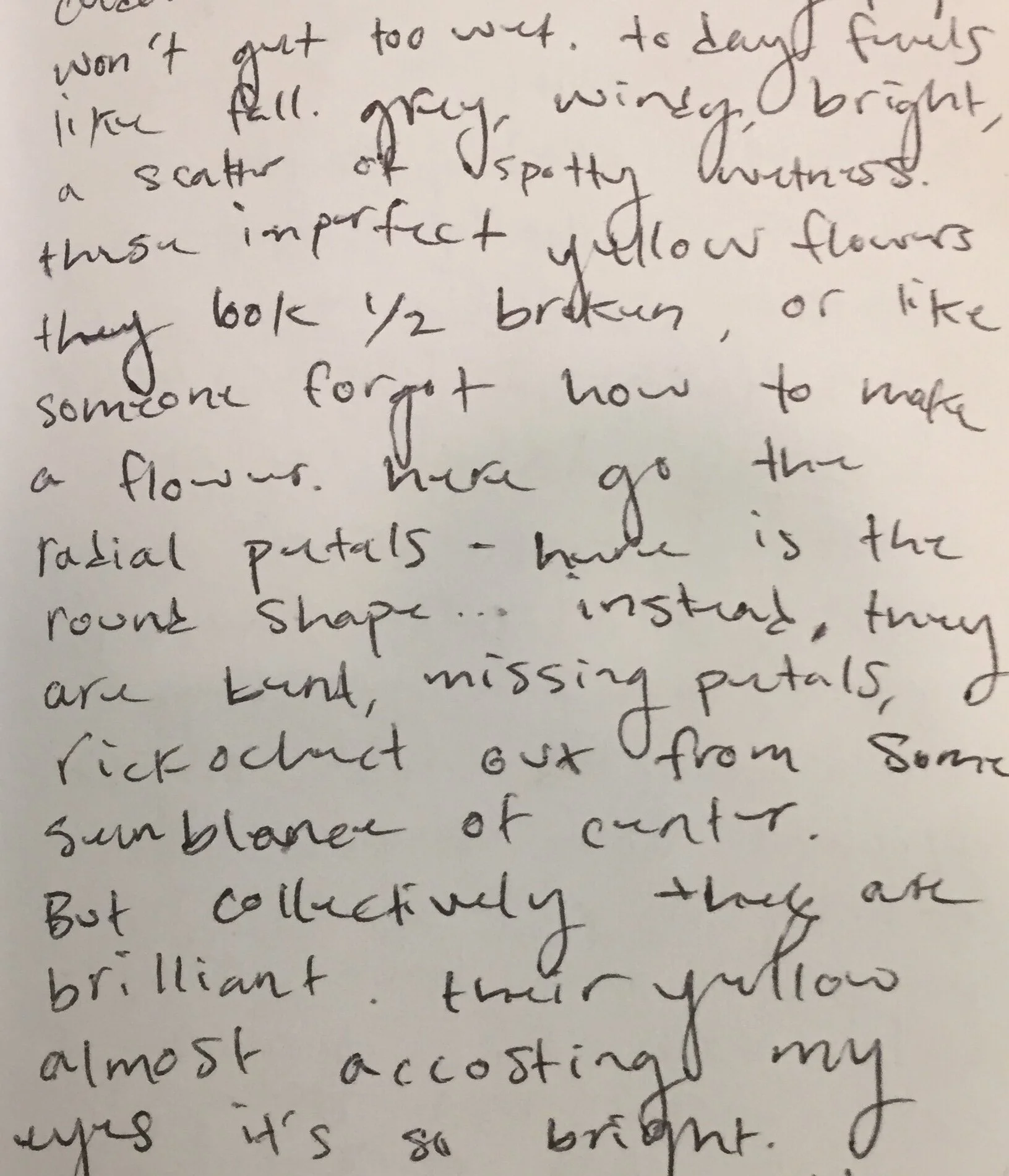
Leah Wilks is a choreographer, dancer, and teacher based out of Brooklyn, NY (Munsee Lenape and Canarsie land) and Durham/Orange County, NC (Eno, Lumbee, Shakori, Sissapahaw, and Occaneechi land). At times, she is also a gardener, an elder-care companion, a musician, and a writer. Her research revolves around embodied memory, monuments, and death and dying practices.
Jessica Alexander is a dancer, explorer, and simply curious human being. Currently based in North Carolina, she is dancing, teaching Pilates, and learning about types of clouds, building structures, and the ways the seasons change.
Instagram @jessicam247
Make a donation to support the artists of P/FPF
We want everyone to be able to access the important and timely work in P/FPF, but if you have the means to do so, we encourage you to make a donation to support the artists. All donations will be directed towards the artists.



